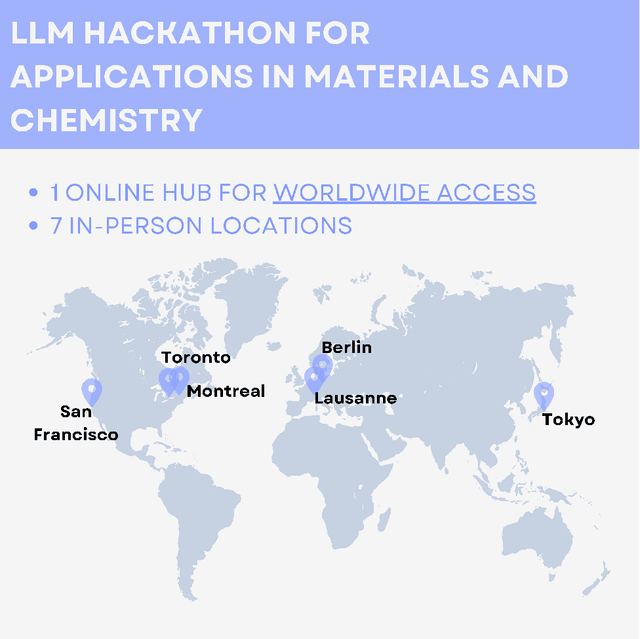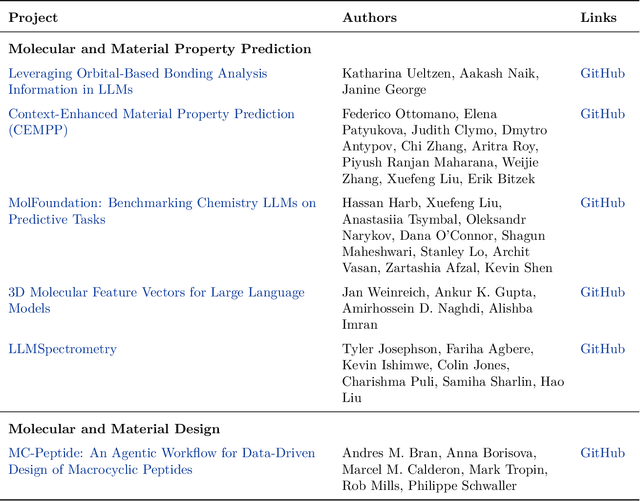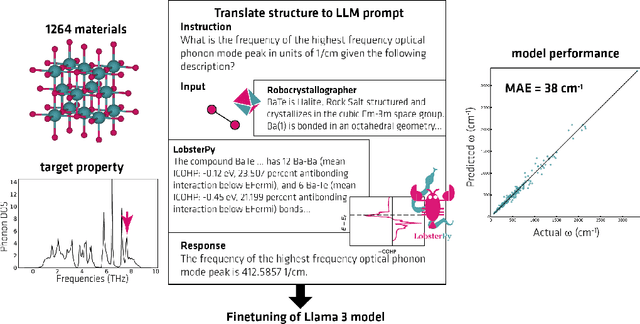Defne Circi
Reflections from the 2024 Large Language Model (LLM) Hackathon for Applications in Materials Science and Chemistry
Nov 20, 2024



Abstract:Here, we present the outcomes from the second Large Language Model (LLM) Hackathon for Applications in Materials Science and Chemistry, which engaged participants across global hybrid locations, resulting in 34 team submissions. The submissions spanned seven key application areas and demonstrated the diverse utility of LLMs for applications in (1) molecular and material property prediction; (2) molecular and material design; (3) automation and novel interfaces; (4) scientific communication and education; (5) research data management and automation; (6) hypothesis generation and evaluation; and (7) knowledge extraction and reasoning from scientific literature. Each team submission is presented in a summary table with links to the code and as brief papers in the appendix. Beyond team results, we discuss the hackathon event and its hybrid format, which included physical hubs in Toronto, Montreal, San Francisco, Berlin, Lausanne, and Tokyo, alongside a global online hub to enable local and virtual collaboration. Overall, the event highlighted significant improvements in LLM capabilities since the previous year's hackathon, suggesting continued expansion of LLMs for applications in materials science and chemistry research. These outcomes demonstrate the dual utility of LLMs as both multipurpose models for diverse machine learning tasks and platforms for rapid prototyping custom applications in scientific research.
Evaluating Morphological Compositional Generalization in Large Language Models
Oct 16, 2024Abstract:Large language models (LLMs) have demonstrated significant progress in various natural language generation and understanding tasks. However, their linguistic generalization capabilities remain questionable, raising doubts about whether these models learn language similarly to humans. While humans exhibit compositional generalization and linguistic creativity in language use, the extent to which LLMs replicate these abilities, particularly in morphology, is under-explored. In this work, we systematically investigate the morphological generalization abilities of LLMs through the lens of compositionality. We define morphemes as compositional primitives and design a novel suite of generative and discriminative tasks to assess morphological productivity and systematicity. Focusing on agglutinative languages such as Turkish and Finnish, we evaluate several state-of-the-art instruction-finetuned multilingual models, including GPT-4 and Gemini. Our analysis shows that LLMs struggle with morphological compositional generalization particularly when applied to novel word roots, with performance declining sharply as morphological complexity increases. While models can identify individual morphological combinations better than chance, their performance lacks systematicity, leading to significant accuracy gaps compared to humans.
Extracting Polymer Nanocomposite Samples from Full-Length Documents
Mar 01, 2024Abstract:This paper investigates the use of large language models (LLMs) for extracting sample lists of polymer nanocomposites (PNCs) from full-length materials science research papers. The challenge lies in the complex nature of PNC samples, which have numerous attributes scattered throughout the text. The complexity of annotating detailed information on PNCs limits the availability of data, making conventional document-level relation extraction techniques impractical due to the challenge in creating comprehensive named entity span annotations. To address this, we introduce a new benchmark and an evaluation technique for this task and explore different prompting strategies in a zero-shot manner. We also incorporate self-consistency to improve the performance. Our findings show that even advanced LLMs struggle to extract all of the samples from an article. Finally, we analyze the errors encountered in this process, categorizing them into three main challenges, and discuss potential strategies for future research to overcome them.
14 Examples of How LLMs Can Transform Materials Science and Chemistry: A Reflection on a Large Language Model Hackathon
Jun 13, 2023



Abstract:Chemistry and materials science are complex. Recently, there have been great successes in addressing this complexity using data-driven or computational techniques. Yet, the necessity of input structured in very specific forms and the fact that there is an ever-growing number of tools creates usability and accessibility challenges. Coupled with the reality that much data in these disciplines is unstructured, the effectiveness of these tools is limited. Motivated by recent works that indicated that large language models (LLMs) might help address some of these issues, we organized a hackathon event on the applications of LLMs in chemistry, materials science, and beyond. This article chronicles the projects built as part of this hackathon. Participants employed LLMs for various applications, including predicting properties of molecules and materials, designing novel interfaces for tools, extracting knowledge from unstructured data, and developing new educational applications. The diverse topics and the fact that working prototypes could be generated in less than two days highlight that LLMs will profoundly impact the future of our fields. The rich collection of ideas and projects also indicates that the applications of LLMs are not limited to materials science and chemistry but offer potential benefits to a wide range of scientific disciplines.
 Add to Chrome
Add to Chrome Add to Firefox
Add to Firefox Add to Edge
Add to Edge